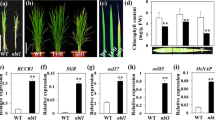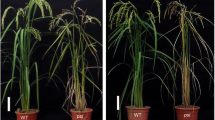Abstract
Senescence is the final stage of plant development. Although expression of most of the genes is suppressed during senescence, a set of genes referred as senescence-associated genes (SAGs) is induced. Arabidopsis thaliana SAG12 (AtSAG12) is one such gene that has been mostly studied for its strict association with senescence. AtSAG12 encodes a papain-like cysteine protease, expressed predominantly in senescence-associated vacuoles. Rice genome contains multiple AtSAG12 homologues (OsSAGs). OsSAG12-1, the closest structural homologue of AtSAG12, is a negative regulator of developmental and stress-induced cell death. Proteolytic activity has not been established for any SAG12 homologues in vitro. Here, we report that OsSAG12-2, the second structural homologue of AtSAG12 from rice, codes for a functional proteolytic enzyme. The recombinant OsSAG12-2 protein produced in Escherichia coli undergoes autolysis to generate a functional protease. The matured OsSAG12-2 protein shows 27% trypsin-equivalent proteolytic activity on azocasein substrate. Dark-induced senescence activates OsSAG12-2 expression. Down-regulation of OsSAG12-2 in the transgenic artificial miRNA lines results in enhanced salt- and UV-induced cell death, even though it does not affect cell viability in the stress-free condition. Our results show that OsSAG12-2 codes for a functional protease that negatively regulates stress-induced cell death in rice.






Similar content being viewed by others
References
Bhattacharjee L, Singh PK, Singh S and Nandi AK 2015 Down-regulation of rice serpin gene OsSRP-LRS exaggerates stress-induced cell death. J. Plant Biol. 58 327–332
Carrion CA, Costa ML, Martinez DE, Mohr C, Humbeck K and Guiamet JJ 2013 In vivo inhibition of cysteine proteases provides evidence for the involvement of 'senescence-associated vacuoles' in chloroplast protein degradation during dark-induced senescence of tobacco leaves. J. Exp. Bot. 64 4967–4980
Chomczynski P and Sachhi N 1987 single step method of RNA isolation by acid guanidinium thiocyanate-phenol-chloroform extraction. Anal. Biochem. 162 156–159
Guo Y and Gan S 2005 Leaf senescence: signals, execution, and regulation. Curr. Top. Dev. Biol. 71 83–112
Lim PO, Kim HJ and Nam HG 2007 Leaf senescence. Annu. Rev. Plant Biol. 58 115–136
Liu F, Vantoai T, Moy LP, Bock G, Linford LD and Quackenbush J 2005 Global transcription profiling reveals comprehensive insights into hypoxic response in Arabidopsis. Plant Physiol. 137 1115–1129
Martinez DE, Bartoli CG, Grbic V and Guiamet JJ 2007 Vacuolar cysteine proteases of wheat (Triticum aestivum L.) are common to leaf senescence induced by different factors. J. Exp. Bot. 58 1099–1107
McCabe MS, Garratt LC, Schepers F, Jordi WJ, Stoopen GM, Davelaar E, van Rhijn JH, Power JB, et al. 2001 Effects of P(SAG12)-IPT gene expression on development and senescence in transgenic lettuce. Plant Physiol. 127 505–516
Miller JD, Arteca RN and Pell EJ 1999 Senescence-associated gene expression during ozone-induced leaf senescence in Arabidopsis. Plant Physiol. 120 1015–1024
Nandi AK, Basu D, Das S and Sen SK 1999 High level expression of soybean trypsin inhibitor gene in transgenic tobacco plants failed to confer resistance against damage caused by Helicoverpa armigera. J. Biosci. 24 445–452
Nandi AK, Kushalappa K, Prasad K and Vijayraghavan U 2000 A conserved function for Arabidopsis SUPERMAN in regulating floral-whorl cell proliferation in rice, a monocotyledonous plant. Curr. Biol. 10 215–218
Otegui MS, Noh YS, Martinez DE, Vila Petroff MG, Staehelin LA, Amasino RM and Guiamet JJ 2005 Senescence-associated vacuoles with intense proteolytic activity develop in leaves of Arabidopsis and soybean. Plant J. 41 831–844
Pace CN and Barrett AJ 1984 Kinetics of tryptic hydrolysis of the arginine-valine bond in folded andunfolded ribonuclease T1. Biochem. J. 219 411–417
Pak C and van Doorn WG 2005 Delay of Iris flower senescence by protease inhibitors. New Phytol. 165 473–480
Roberts IN, Caputo C, Criado MV and Funk C 2012 Senescence-associated proteases in plants. Physiol. Plant 145 130–139
Singh S, Giri MK, Singh PK, Siddiqui A and Nandi AK 2013a Down-regulation of OsSAG12-1 results in enhanced senescence and pathogen-induced cell death in transgenic rice plants. J. Biosci. 38 583–592
Singh V, Singh PK, Siddiqui A, Singh S, Banday ZZ, and Nandi AK 2016. Over-expression of Arabidopsis thaliana SFD1/GLY1, the gene encoding plastid localized glycerol-3-phosphate dehydrogenase, increases plastidic lipid content in transgenic rice plants. J. Plant Res. in press
Singh V, Roy S, Giri MK, Chaturvedi R, Chowdhury Z, Shah J and Nandi AK 2013b Arabidopsis thaliana FLOWERING LOCUS D is required for systemic acquired resistance. Mol. Plant Microbe Interact 26 1079–1088
Sykorova B, Kuresova G, Daskalova S, Trckova M, Hoyerova K, Raimanova I, Motyka V, Travnickova A, et al. 2008 Senescence-induced ectopic expression of the A. tumefaciens ipt gene in wheat delays leaf senescence, increases cytokinin content, nitrate influx, and nitrate reductase activity, but does not affect grain yield. J. Exp. Bot. 59 377–387
Wang H, Chen C, Xu Y, Jiang R, Han Y, Xu Z and Chong K 2004 A practical vector for efficient knockdown of gene expression in rice (Oryza sativaL.). Plant Mol. Biol. Report. 22 409–417
Warthmann N, Chen H, Ossowski S, Weigel D and Hervé P 2008 Highly specific gene silencing by artificial miRNAs in rice. PLoS ONE 3 e1829
Acknowledgements
We acknowledge Kang Chong, Institute of Botany, Chinese Academy of Science, Beijing, for providing pTCK303 vector. This work is supported by DST grant (SR/SO/PS-29/2006) and DST-PURSE to AKN; CSIR fellowship to SS; and UGC fellowship to AS.
Author information
Authors and Affiliations
Corresponding author
Additional information
Corresponding editor: Utpal Nath
[Singh S, Singh A and Nandi AK 2016 The rice OsSAG12-2 gene codes for a functional protease that negatively regulates stress-induced cell death. J. Biosci.]
Electronic supplementary material
Below is the link to the electronic supplementary material.
ESM 1
(PDF 154 kb)
Rights and permissions
About this article
Cite this article
Singh, S., Singh, A. & Nandi, A.K. The rice OsSAG12-2 gene codes for a functional protease that negatively regulates stress-induced cell death. J Biosci 41, 445–453 (2016). https://doi.org/10.1007/s12038-016-9626-9
Received:
Accepted:
Published:
Issue Date:
DOI: https://doi.org/10.1007/s12038-016-9626-9




